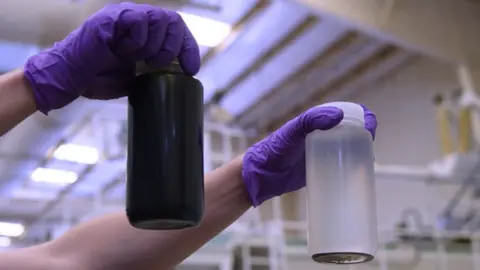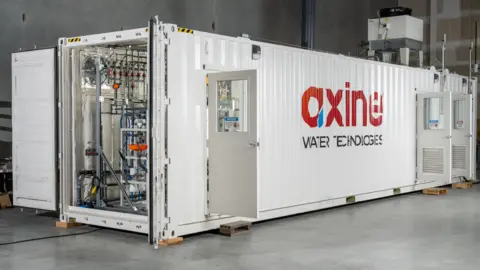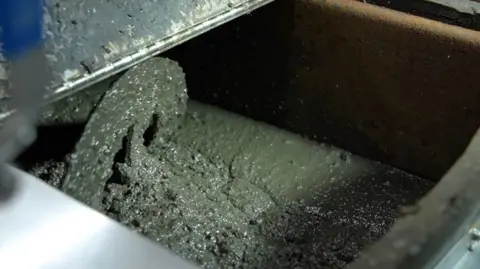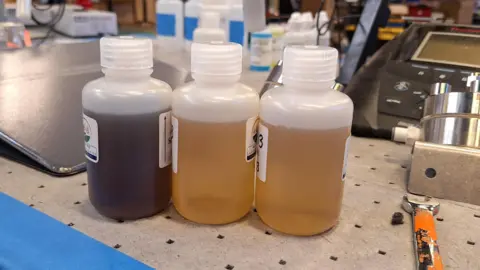Business
The firms looking to destroy harmful ‘forever chemicals’

Technology Reporter
 374Water
374Water“There’s a lot of destruction that needs to be done,” sums up Parker Bovée of Cleantech Group, a research and consulting firm.
He is referring to PFAS (Perfluoroalkyl and Polyfluoroalkyl Substances), also known as “forever chemicals”.
These man-made chemicals can be found in items such as waterproof clothing, non-stick pans, lipsticks and food packaging.
They are used for their grease and water repellence, but do not degrade quickly and have been linked to health issues such as higher risks of certain cancers and reproductive problems.
The extraordinarily strong carbon-fluorine bonds they contain gives them the ability to persist for decades or even centuries in nature.
PFAS can be detected and removed from water and soil and then concentrated into smaller volumes of high strength waste.
But what to do with that waste?
Currently, concentrated PFAS waste is either put in long-term storage which is expensive, or incinerated (often incompletely, leading to toxic emissions), or sent to landfills for hazardous waste.
But now clean-tech companies are bringing techniques to market that can destroy them.
These are being tested in small-scale pilot projects with potential customers including some industrial manufacturers, municipal wastewater treatment plants and even the US military.
There’s a “large and growing” market opportunity for PFAS destruction companies notes Mr Bovée.
While it is mostly currently centred in the US, others are dipping their toes, he says.
In the UK, funding for water companies to look into PFAS destruction has been provided by water regulator Ofwat, with Severn Trent Water leading a project to examine the potential technologies and suppliers.
One factor driving the market forward in the US is legal risk. Thousands of lawsuits claiming PFAS-related contamination and harm have been filed with some large chemical manufacturers, notably 3M, having already paid out billions in class-action settlements.
Regulation is also beginning to tighten worldwide.
Legal limits for two PFAS in drinking water are now scheduled to take effect in the US in 2031.
PFAS remains a bipartisan issue, says Mr Bovée, and many expect that future US regulation will expand beyond drinking water to cover industrial discharge and other sources.
The EU also has legal limits for PFAS in drinking water, which member states must begin enforcing from next year.
 Axine Water Technologies
Axine Water TechnologiesThere are a variety of technologies for destroying PFAS – each with their own advantages and limitations.
According to Mr Bovée, one technology that is almost commercially ready is electrochemical oxidation (EO) technology.
Electrodes are placed in water contaminated by PFAS and a current is passed through, resulting in the chemicals’ breakdown.
While energy intensive, it doesn’t require high temperature or pressure, and is easy to operate and integrate into existing treatment systems for concentrating PFAS, says Mark Ralph, CEO of Canadian-based start-up Axine Water Technologies.
Last year, following a successful pilot project, it sold its first commercial-scale unit to a Michigan-based producer of automotive components. It is now up and running and the customer is planning to purchase additional systems for other sites.
 374Water
374WaterAnother technology not far behind is Supercritical Water Oxidation (SCWO).
It relies on heating and pressurising water to such a high degree that it enters a new state of matter: a so-called supercritical state. When the PFAS waste stream is introduced, it breaks the carbon-fluorine bonds.
One advantage is that it can process both solid and liquid PFAS waste, says Chris Gannon, CEO of North Carolina-based 374Water.
He says his technology can even destroy PFAS in plastics if they are ground up.
It can be expensive to buy and maintain – the process is so intense it requires a complex reactor and regular cleaning. But it can be more cost effective if the PFAS is first concentrated before it enters the process.
Currently the City of Orlando in Florida is testing 374Water’s technology at its largest wastewater treatment plant.
The City is trying to get ahead of the curve, explains Alan Oyler, its special projects manager for public works.
Levels of PFAS in sewage sludge aren’t currently regulated, but he expects them to be in the future.
So far, Mr Oyler is pleased with the destruction capability he has seen, but is also waiting to see how reliable the system is.
The scale of 374Water’s current technology is small: it can handle just a fraction of the tonnes of wet sludge the facility produces daily.
But the company is in the process of scaling up, and Mr Oyler imagines in a few years it will be able to handle all the facility’s material “ready for when the regulations require”.
Other technologies on their way to being commercially ready include hydrothermal alkaline treatment (HALT), which uses high temperature, high pressure, and an alkaline chemical to destroy PFAS; and plasma-based technology, which involves making an ionized gas (called a plasma) to attack and degrade the PFAS molecules.
 Aquagga
AquaggaYet there is one potential issue with the technologies now coming through, says Jay Meegoda, a professor of civil and environmental engineering at the New Jersey Institute of Technology: nasty PFAS degradation byproducts.
For example, in the case of EO, highly corrosive hydrogen fluoride vapor. Each needs a “complete study” accounting for all their inputs and outputs, he says.
The companies have claimed they either don’t produce PFAS degradation products or deal with them adequately.
One important partner for many of the PFAS destruction companies in testing their technologies in the real world has been the US Department of Defence (DOD).
PFAS contamination at US military sites is a big, below-the-radar problem. It stems particularly from the use of older formulations of firefighting foam, used for example during training exercises or emergencies, but other routes too such as the cleaning of military equipment.
More than 700 sites are known or suspected to be contaminated, posing a threat to surrounding communities. A judge recently cleared the way for PFAS contamination and harm lawsuits against the military to proceed.
Clean up efforts are where the destruction companies could come in, and projects have been undertaken or are under way at various sites to assess the performance and cost effectiveness of many of their solutions.
One start-up, Aquagga, which specialises in HALT technology, recently completed a demonstration project for the DOD which involved destroying a firefighting foam mixture amongst other concentrated PFAS-containing liquids.
Immense volumes of the foam are currently stockpiled in all sorts of places, not just at military sites.
Like others, Aquagga sees a big opportunity over the next few years for both destroying the foam and remediating the environmental damage associated with its use.
And outside the military, there’s a tantalizing new PFAS waste stream on the horizon. The US is actively expanding domestic computer chip manufacturing – a process that uses PFAS in massive amounts. “We can destroy that,” says Mr Gannon, of 374Water.
Business
Private sector data: Over 2 lakh private companies closed in 5 years; govt flags monitoring for suspicious cases – The Times of India

NEW DELHI: The government on Monday said that over the past five years, more than two lakh private companies have been closed in India.According to data provided by Minister of State for Corporate Affairs Harsh Malhotra in a written reply to the Lok Sabha, a total of 2,04,268 private companies were shut down between 2020-21 and 2024-25 due to amalgamation, conversion, dissolution or being struck off from official records under the Companies Act, 2013.Regarding the rehabilitation of employees from these closed companies, the minister said there is currently no proposal before the government, as reported by PTI. In the same period, 1,85,350 companies were officially removed from government records, including 8,648 entities struck off till July 16 this fiscal year. Companies can be removed from records if they are inactive for long periods or voluntarily after fulfilling regulatory requirements.On queries about shell companies and their potential use in money laundering, Malhotra highlighted that the term “shell company” is not defined under the Companies Act, 2013. However, he added that whenever suspicious instances are reported, they are shared with other government agencies such as the Enforcement Directorate and the Income Tax Department for monitoring.A major push to remove inactive companies took place in 2022-23, when 82,125 companies were struck off during a strike-off drive by the corporate affairs ministry.The minister also highlighted the government’s broader policy to simplify and rationalize the tax system. “It is the stated policy of the government to gradually phase out exemptions and deductions while rationalising tax rates to create a simple, transparent, and equitable tax regime,” he said. He added that several reforms have been undertaken to promote investment and ease of doing business, including substantial reductions in corporate tax rates for existing and new domestic companies.
Business
Pakistan’s Textile Exports Reach Historic High in FY2025-26 – SUCH TV

Pakistan’s textile exports surged to $6.4 billion during the first four months of the 2025-26 fiscal year, marking the highest trade volume for the sector in this period.
According to the Pakistan Bureau of Statistics (PBS), value-added textile sectors were key contributors to the growth.
Knitwear exports reached $1.9 billion, while ready-made garments contributed $1.4 billion.
Significant increases were observed across several commodities: cotton yarn exports rose 7.74% to $238.9 million, and raw cotton exports jumped 100%, reaching $2.6 million from zero exports the previous year.
Other notable gains included tents, canvas, and tarpaulins, up 32.34% to $53.48 million, while ready-made garments increased 5.11% to $1.43 billion.
Exports of made-up textile articles, excluding towels and bedwear, rose 4.17%, totaling $274.75 million.
The report also mentioned that the growth in textile exports is a result of improved global demand and stability in the value of the Pakistani rupee.
Business
Peel Hunt cheers ‘positive steps’ in Budget to boost London market and investing

UK investment bank Peel Hunt has given some support to under-pressure Chancellor Rachel Reeves over last week’s Budget as it said efforts to boost the London market and invest in UK companies were “positive steps”.
Peel Hunt welcomed moves announced in the Budget, such as the stamp duty exemption for shares bought in newly listed firms on the London market and changes to Isa investing.
It comes as Ms Reeves has been forced to defend herself against claims she misled voters by talking up the scale of the fiscal challenge in the run-up to last week’s Budget, in which she announced £26 billion worth of tax rises.
Peel Hunt said: “Following a prolonged period of pre-Budget speculation, businesses and investors now have greater clarity from which they can start to plan.
“The key measures were generally well received by markets, particularly the creation of additional headroom against the Chancellor’s fiscal rules.
“Initiatives such as a stamp duty holiday on initial public offerings (IPOs) and adjustments to the Isa framework are intended to support UK capital markets and encourage investment in British companies.
“These developments, alongside the Entrepreneurship in the UK paper published simultaneously, represent positive steps toward enhancing the UK’s attractiveness for growth businesses and long-term investors.”
Ms Reeves last week announced a three-year stamp duty holiday on shares bought in new UK flotations as part of a raft of measures to boost investment in UK shares.
She also unveiled a change to the individual savings account (Isa) limit that lowers the cash element to £12,000 with the remaining £8,000 now redirected into stocks and shares.
But the Chancellor also revealed an unexpected increase in dividend tax, rising by 2% for basic and higher rate taxpayers next year, which experts have warned “undermines the drive to increase investing in Britain”.
Peel Hunt said the London IPO market had begun to revive in the autumn, although listings activity remained low during its first half to the end of September.
Firms that have listed in London over recent months include The Beauty Tech Group, small business lender Shawbrook and tinned tuna firm Princes.
Peel Hunt added that deal activity had “continued at pace” throughout its first half, with 60 transactions announced across the market during that time and 10 active bids for FTSE 350 companies, as at the end of September.
Half-year results for Peel Hunt showed pre-tax profits jumped to £11.5 million in the six months to September 30, up from £1.2 million a year earlier, as revenues lifted 38.3%.
Peel Hunt said its workforce has been cut by nearly 10% since the end of March under an ongoing savings drive, with full-year underlying fixed costs down by around £5 million.
Steven Fine, chief executive of Peel Hunt, said: “The second half has started strongly, with the group continuing to play leading roles across both mergers and acquisitions and equity capital markets mandates.”
-

 Sports1 week ago
Sports1 week agoWATCH: Ronaldo scores spectacular bicycle kick
-

 Entertainment1 week ago
Entertainment1 week agoWelcome to Derry’ episode 5 delivers shocking twist
-

 Politics1 week ago
Politics1 week agoWashington and Kyiv Stress Any Peace Deal Must Fully Respect Ukraine’s Sovereignty
-

 Business1 week ago
Business1 week agoKey economic data and trends that will shape Rachel Reeves’ Budget
-

 Tech6 days ago
Tech6 days agoWake Up—the Best Black Friday Mattress Sales Are Here
-

 Politics1 week ago
Politics1 week ago53,000 Sikhs vote in Ottawa Khalistan Referendum amid Carney-Modi trade talks scrutiny
-

 Fashion1 week ago
Fashion1 week agoCanada’s Lululemon unveils team Canada kit for Milano Cortina 2026
-

 Tech23 hours ago
Tech23 hours agoGet Your Steps In From Your Home Office With This Walking Pad—On Sale This Week






